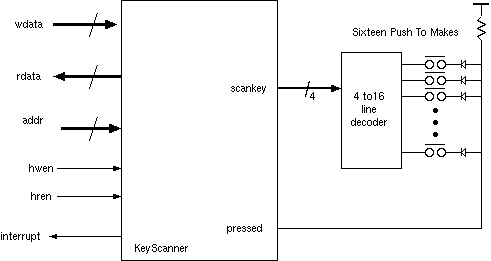HOME
UP
PREV
FURTHER NOTES
NEXT (Counter/Timer Block)
Keyboard Controller (scan multiplexed type).
Resistive switches shown (most keyboards and touch screens now use capacitive rather than resistive).
 | output [3:0] scankey;
input pressed;
reg int_enable, pending;
reg [3:0] scankey, pkey;
always @(posedge clk) begin
if (!pressed) pkey <= scankey;
else scankey <= scankey + 1;
if (hwen) int_enable <= wdata[0]
pressed1 <= pressed;
if (!pressed1 && pressed) pending <= 1;
if (hren) pending <= 0;
end
assign interrupt = pending && int_enable;
assign rdata = { 28'b0, pkey };
|
This keyboard scanner generates an interrupt on each key press.
In practice, scan more slowly and use extra register on asynchronous input pressed (metastability).
Also, have more than one input wire (use a close to square array).
Typically use a separate microcontroller to scan keyboard.
Standard PC keyboard generates an output byte on press and release
and implements a FIFO in case MS DOS busy.
